What is Mendel’s Law of Segregation?
- Mendel’s Law of Segregation is a fundamental principle of genetics that describes how alleles for a given gene separate during gamete formation. The law states that each gamete receives only one allele for each gene, either dominant or recessive, and this allocation occurs randomly.
- In essence, Mendel’s Law of Segregation asserts that an organism possesses two alleles for each gene, one inherited from each parent. During the process of gametogenesis, these alleles segregate so that each gamete contains only one allele for each gene. This segregation ensures that the alleles do not mix or blend but rather separate into different gametes.
- This principle is grounded in several key concepts. Firstly, a gene can exist in different forms called alleles. During gamete formation, the pair of alleles for a gene separates, meaning each gamete carries only one allele. Consequently, all organisms inherit two alleles for each trait, with one allele being dominant and the other recessive.
- The law of segregation is particularly useful in predicting genetic outcomes. It enables the use of Punnett squares to estimate the genotypic ratios of offspring from a genetic cross, based on the random and equal segregation of alleles.
- Furthermore, Mendel’s Law of Segregation was instrumental in challenging the blending theory of inheritance. By demonstrating that recessive traits could reappear in subsequent generations, Mendel showed that hereditary factors remain distinct entities, even when they are temporarily combined in hybrids.
- Overall, Mendel’s Law of Segregation provides a foundational understanding of genetic inheritance by explaining how alleles separate during gamete formation and contribute to the inheritance of traits.
Mendel’s Law of Segregation Definition
Mendel’s Law of Segregation states that alleles for a trait separate during gamete formation, ensuring each gamete carries only one allele, randomly inherited from the parent.
What is segregation?
- Segregation refers to the fundamental genetic process in which pairs of alleles, representing different traits of the same gene, are separated and distributed into separate gametes during meiosis. This process ensures that each gamete carries only one allele for a particular trait.
- Meiosis is a specialized cell division that occurs in sexually reproducing organisms. During meiosis, the homologous chromosomes, which carry genes that determine various traits, align and then segregate into distinct daughter cells. This segregation of alleles guarantees genetic diversity among offspring.
- The significance of segregation lies in its contribution to genetic variation and inheritance patterns. By ensuring that each gamete receives only one allele from each gene pair, segregation allows for different combinations of alleles to be passed down to the next generation. This variation is essential for the adaptability and survival of species over time.
- In summary, segregation is a fundamental genetic principle that ensures the separation of allele pairs during meiosis, leading to the inheritance of diverse genetic traits among offspring.
Principle of Segregation and its Importance
- The principle of segregation is a fundamental concept in genetics that plays a pivotal role in explaining the inheritance of genetic traits. This principle, proposed by Gregor Mendel, states that individuals possess two alleles for a specific characteristic, and during the formation of gametes, these alleles segregate or separate from each other. As a result, only one allele is present in each gamete.
- In simpler terms, if an individual carries two different alleles for a particular trait (heterozygous), such as one allele for brown eyes and another for blue eyes, these alleles separate during the formation of gametes. As a consequence, each gamete carries only one allele for that trait, either the allele for brown eyes or the allele for blue eyes.
- The importance of the principle of segregation lies in its role in shaping the genetic diversity within populations and the inheritance patterns observed in offspring. By ensuring that each gamete contains only one allele from each gene pair, segregation contributes to the random assortment of alleles during fertilization. This random assortment generates a wide array of genetic combinations, leading to the diversity of traits in subsequent generations.
- Furthermore, the principle of segregation is the foundation for understanding genotypic ratios and predicting the outcomes of genetic crosses. It enables scientists to use tools like Punnett squares to estimate the potential genotypes of offspring resulting from various mating scenarios.
- In summary, the principle of segregation elucidates how alleles separate during gamete formation, leading to the presence of only one allele in each gamete. This process contributes to genetic diversity and is essential for understanding inheritance patterns, genotypic ratios, and the overall mechanism of genetic variation within populations.
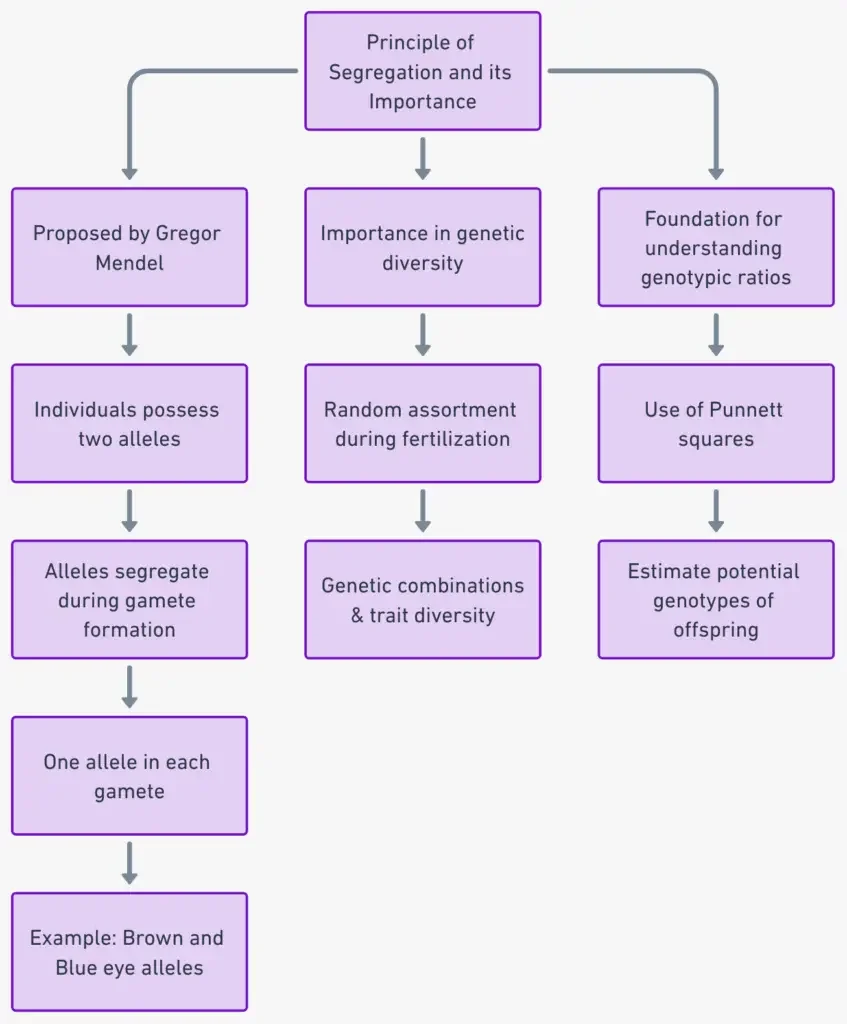
Characteristics of Mendel’s Law of Segregation
- Phase of Meiosis
Mendel’s Law of Segregation is based on the first phase of meiotic cell division, where homologous chromosomes, each carrying two copies of the same gene, are separated into individual daughter nuclei. This separation ensures that each gamete receives only one allele for each gene. - Segregation of Alleles
During meiosis, the division of homologous chromosomes results in the segregation of alleles at a gene locus. This process generates gametes that carry one allele from each pair of homologous chromosomes. Therefore, each gamete has only one allele for each gene. - Monohybrid Cross Example
The principle can be illustrated through a monohybrid cross between tall and dwarf pea plants. Assuming the tall plant is homozygous (RR) and the dwarf plant is homozygous recessive (rr), the tall plant produces gametes with a single R allele, while the dwarf plant produces gametes with a single r allele. - Gamete Formation
Each gamete contains only one allele from each pair due to the segregation of homologous chromosomes. Upon fertilization, the gametes fuse to form a heterozygous plant with Rr alleles. This plant exhibits the dominant trait (tallness) due to the presence of the dominant R allele. - Expression in Hybrids
In the resulting hybrid (F1 generation), the dominant R allele partially expresses itself, while the recessive allele remains unexpressed. This demonstrates that although both alleles are present, their effects can be masked by the dominant allele. - Genotypic Combinations
The law of segregation explains that during the formation of gametes, alleles segregate independently. Therefore, in a monohybrid cross, the resulting genotypes can be RR, Rr, or rr, representing the possible combinations of the dominant and recessive alleles.
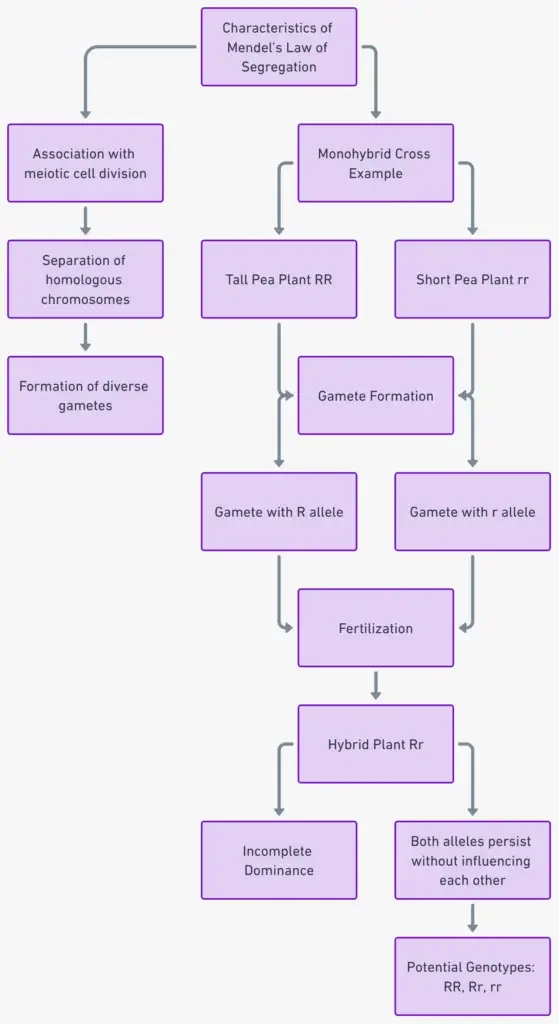
Examples of Mendel’s Law of Segregation
- Morgan’s Work on Drosophila
T. H. Morgan’s experiments with Drosophila melanogaster provide a clear example of Mendel’s Law of Segregation. In his study, Morgan crossed homozygous long-winged Drosophila (v+v+) with homozygous vestigial-winged Drosophila (vv). During meiosis, the long-winged Drosophila produces gametes with a single v+ allele, while the vestigial-winged Drosophila produces gametes with a single v allele.Upon fertilization, these gametes combine to form hybrids with v+v alleles, which are phenotypically long-winged due to the dominance of the v+ allele. This experiment demonstrates the segregation of alleles during gamete formation and how they recombine in offspring to produce distinct genotypes and phenotypes. Therefore, the process validates the principle that alleles separate and assort independently during gamete formation. - Albinism in Humans
Albinism in humans serves as another illustrative example of Mendel’s Law of Segregation. Albinism results from a recessive trait that causes a lack of pigmentation. The dominant allele (A) is associated with normal pigmentation, while the recessive allele (a) is associated with albinism.In a genetic cross between a homozygous dominant individual (AA) and a homozygous recessive individual (aa), the gametes produced will carry either A or a alleles. When these gametes combine, the resulting hybrids (Aa) exhibit normal pigmentation, as the dominant allele masks the recessive one. However, if two Aa individuals are crossed, the law of segregation predicts that the offspring can have genotypes AA, Aa, or aa. The presence of the recessive aa genotype results in albinism, due to the absence of the enzyme tyrosinase required for melanin production.
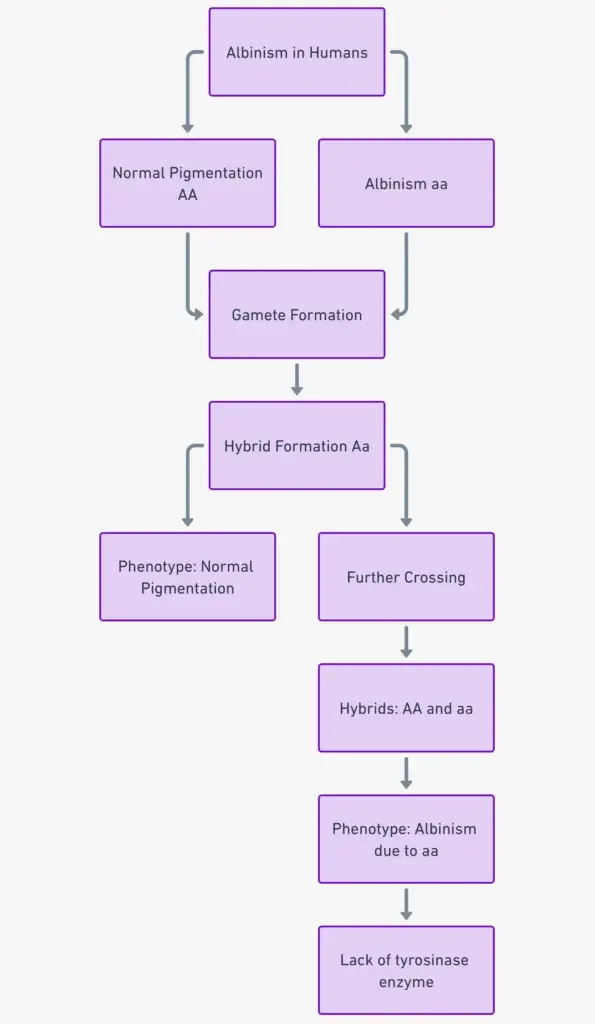
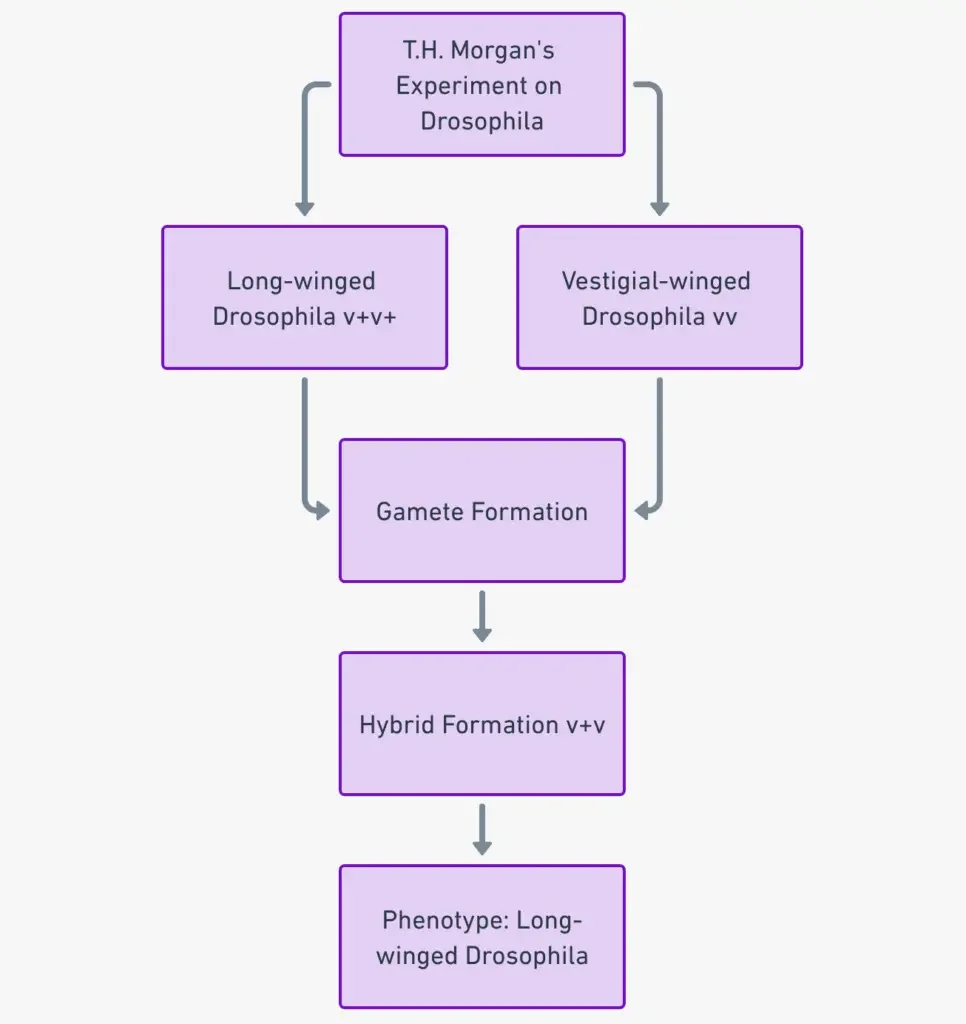
Why is Mendel’s Law of Segregation defined as the purity law of gametes?
Mendel’s Law of Segregation, also known as the First Law of Mendel, is often referred to as the “purity law of gametes” because it describes how alleles for a single trait segregate (or separate) so that each gamete carries only one allele for each gene. Here’s a breakdown of why it’s called the purity law:
- Alleles and Homozygous/Heterozygous Conditions: Genes come in different versions called alleles. An organism can either have two of the same alleles (homozygous) or two different alleles (heterozygous) for a given gene.
- Formation of Gametes: During the formation of gametes (sperm and egg cells in animals, pollen and ovules in plants), the two alleles for each gene separate from each other. This process occurs during meiosis, a type of cell division that reduces the chromosome number by half.
- Purity of Gametes: As a result of this separation, each gamete receives only one allele for each gene. This ensures that gametes are “pure” in terms of their genetic information for a particular gene. For example, if an organism is heterozygous (Aa) for a gene, its gametes will either carry the A allele or the a allele, but not both.
- Fertilization: When two gametes fuse during fertilization, the resulting offspring will have two alleles for each gene—one from each parent. This restores the diploid number of chromosomes in the offspring.
Mendel derived this law from his experiments with pea plants. He observed that when he crossed plants with two different traits (e.g., yellow seeds vs. green seeds), the first generation (F1) showed only one of the traits (e.g., all yellow seeds). However, when he allowed the F1 generation to self-fertilize, the second generation (F2) showed a 3:1 ratio of the traits (e.g., 3 yellow seeds for every 1 green seed). This indicated that the alleles had separated during gamete formation in the F1 plants, leading to the reappearance of the green seed trait in the F2 generation.
In summary, Mendel’s Law of Segregation is termed the “purity law of gametes” because it explains how alleles separate during gamete formation, ensuring that each gamete carries only one allele for each gene, maintaining the “purity” of genetic information.
Example
Mendelian traits have alleles that can be dominant or recessive, which are inherited from parents to offspring. In plants, the flower’s color is determined by the inherited allele. Each parent contributes one allele to the offspring. The combination of alleles in the offspring results from the union of two gametes’ chromosomes during fertilization. These chromosomes are randomly separated during gamete formation, with meiosis playing a role in the process.
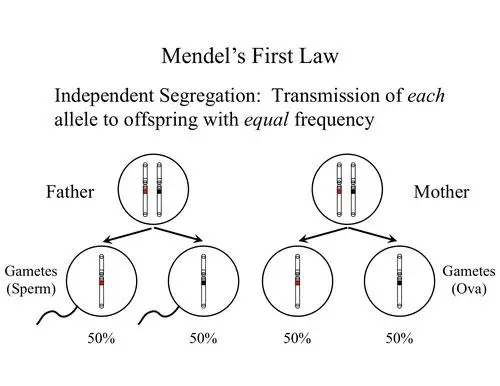
Where does the law of segregation occur in meiosis?
The Law of Segregation is observed during the process of meiosis, specifically during the first division of meiosis, known as meiosis I. Here’s a breakdown of where and how the Law of Segregation occurs in meiosis:
- Prophase I: During this phase, homologous chromosomes (each consisting of two sister chromatids) pair up in a process called synapsis. This pairing forms structures called tetrads. While the Law of Segregation is not directly observed in this phase, the pairing of homologous chromosomes sets the stage for their separation in the next phases.
- Metaphase I: The tetrads align at the metaphase plate in the middle of the cell. The orientation of each homologous pair is random, which leads to genetic variation due to independent assortment. However, the Law of Segregation is still not directly observed here.
- Anaphase I: This is the critical phase where the Law of Segregation is observed. The homologous chromosomes are pulled apart and move to opposite poles of the cell. Importantly, each homologous chromosome carries one allele of a gene, ensuring that the two alleles of a gene present in a diploid cell are separated.
- Telophase I and Cytokinesis: The cell divides into two daughter cells, each with half the original chromosome number (haploid). Each daughter cell contains one chromosome (and therefore one allele) from each homologous pair.
- Meiosis II: This is the second division of meiosis, and it resembles mitosis. The sister chromatids of each chromosome are separated. However, the Law of Segregation primarily pertains to the separation of homologous chromosomes in meiosis I, not the separation of sister chromatids in meiosis II.
Why is the Law of Segregation universally accepted?
The Law of Segregation is universally accepted for several reasons:
- Empirical Evidence: Gregor Mendel’s experiments with pea plants provided clear and repeatable evidence supporting the Law of Segregation. Mendel’s meticulous work and statistical analysis showed consistent patterns of inheritance that could be explained by the separation of alleles during gamete formation.
- Consistency Across Organisms: After Mendel’s findings were rediscovered at the turn of the 20th century, other researchers observed similar patterns of inheritance in various organisms, from fruit flies to humans. The consistency of these observations across diverse species reinforced the universality of the Law of Segregation.
- Molecular Biology Confirmation: With the advent of molecular biology and genetics in the 20th century, the physical basis of Mendel’s laws became clear. The structure and behavior of chromosomes during meiosis directly supported Mendel’s postulates. The discovery of the processes of DNA replication, transcription, and translation further solidified the understanding of genetic inheritance and confirmed Mendel’s findings at the molecular level.
- Predictive Power: The Law of Segregation, along with Mendel’s other laws, provides a robust framework for predicting the outcomes of genetic crosses. This predictive power has been utilized in various fields, from agriculture to medicine, to achieve desired genetic outcomes or understand genetic disorders.
- Integration with Other Genetic Principles: The Law of Segregation integrates seamlessly with other genetic principles and laws, such as the Law of Independent Assortment and the concept of linkage. This integration has allowed for a more comprehensive understanding of genetics and inheritance.
- Challenges and Refinements: While Mendel’s laws provide a foundational understanding of inheritance, they are not without exceptions. Over time, as exceptions and complexities (like linkage, incomplete dominance, and epistasis) were discovered, they didn’t invalidate the Law of Segregation. Instead, they added layers of complexity to our understanding of genetics. The fact that the law held true despite these refinements and challenges further solidified its acceptance.
Limitations of Mendel’s Law of Segregation
- Applicability to Diploid Organisms
Mendel’s Law of Segregation is specific to diploid organisms, which possess two sets of chromosomes and undergo sexual reproduction to form haploid gametes. The law does not apply to organisms with different chromosomal configurations, such as polyploid organisms. - Incomplete Dominance and Codominance
The law does not account for alleles that exhibit incomplete dominance or codominance. In incomplete dominance, neither allele is completely dominant, leading to a blend of traits in the phenotype. In codominance, both alleles are fully expressed, resulting in a phenotype where both traits are visible simultaneously. - Collaborative and Complementary Genes
Mendel’s Law of Segregation is not applicable to traits governed by genes that interact collaboratively or exhibit complementary gene action. In such cases, the expression of a trait is influenced by the interaction of multiple genes rather than a simple dominance-recessive relationship. - Polygenic Traits
The law does not apply to traits that are influenced by multiple gene pairs, known as polygenic traits. For example, traits like skin color and height are controlled by multiple genes, each contributing to the overall phenotype. The law of segregation cannot fully explain the inheritance patterns of such complex traits.
Mendel’s Law of Segregation Mindmap
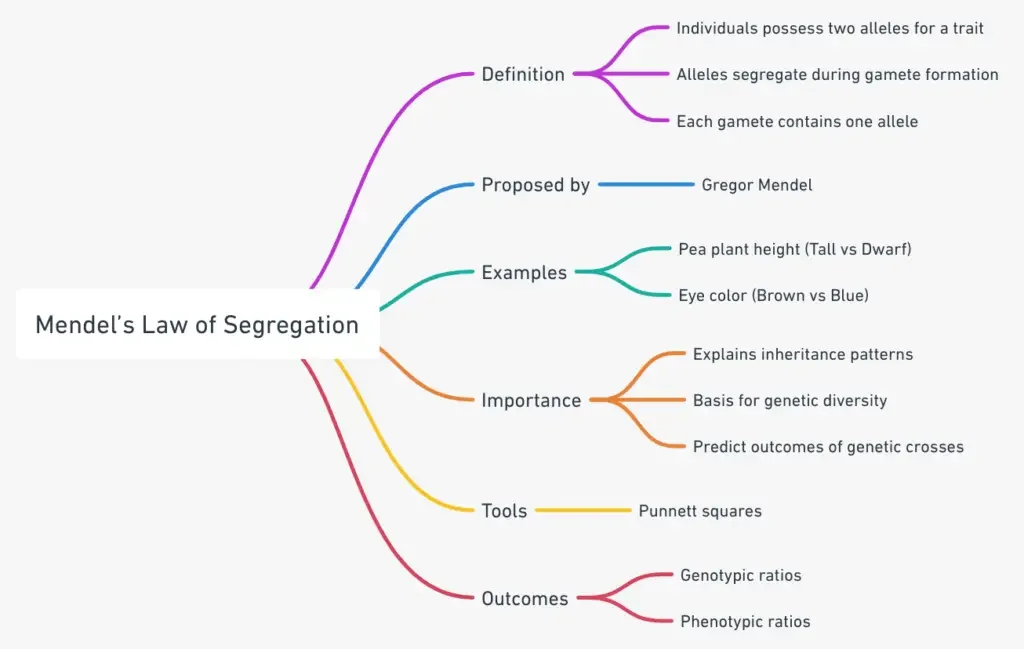
Mendel’s Law of Segregation Infograph
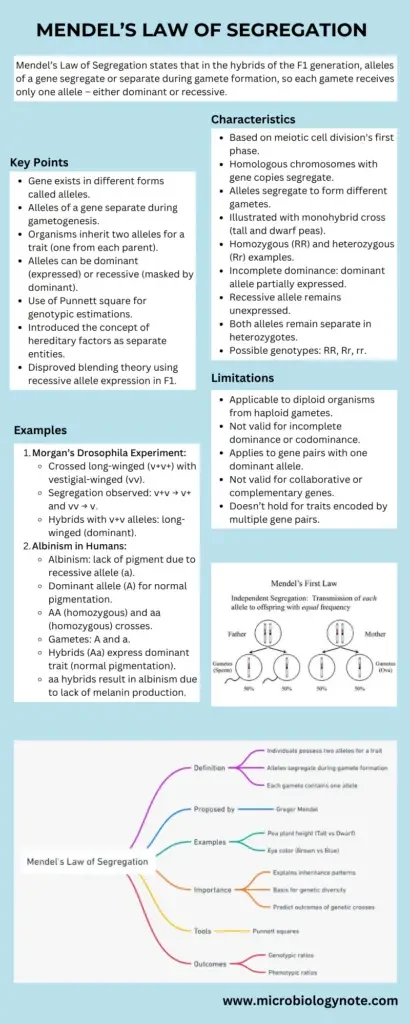
FAQ
What is Mendel’s Law of Segregation?
It is one of the fundamental principles of genetics that states that the two alleles for each gene segregate (separate) during gamete formation, and each gamete carries only one allele for each gene.
Who proposed the Law of Segregation?
The Law of Segregation was proposed by Gregor Mendel, a 19th-century Austrian monk and scientist, based on his experiments with pea plants.
How did Mendel discover this law?
Mendel discovered the law through his breeding experiments with pea plants, where he observed the inheritance patterns of single traits like seed color and flower color.
Why is it called the “Law of Segregation”?
It’s called the “Law of Segregation” because the two alleles for a gene segregate or separate from each other during the formation of gametes.
How does the Law of Segregation relate to meiosis?
During meiosis, the process by which gametes are formed, the paired alleles for each gene segregate so that each gamete receives only one allele.
What happens if an organism is heterozygous for a trait?
If an organism is heterozygous for a trait, it possesses two different alleles for that gene. According to the Law of Segregation, these alleles will separate during gamete formation.
How does the Law of Segregation explain genetic variation?
The law explains genetic variation by stating that offspring inherit a combination of alleles from both parents, leading to diverse genetic makeup.
Is the Law of Segregation always true?
While Mendel’s Law of Segregation applies to many genes, there are exceptions due to phenomena like linkage, where genes located close together on a chromosome tend to be inherited together.
How does the Law of Segregation differ from the Law of Independent Assortment?
The Law of Segregation deals with the separation of alleles for a single gene, while the Law of Independent Assortment refers to the independent inheritance of two or more genes located on different chromosomes.
Why is Mendel’s Law of Segregation important in genetics?
The law forms the foundation of genetic inheritance and provides a basic understanding of how traits are passed from one generation to the next, making it fundamental to the study of genetics.
- Genetics Generation. (2012). Genetics Generation. https://knowgenetics.org/mendelian-genetics/
O’Neil, D. (2012). “Basic Principles of Genetics: Mendel’s Genetics.” Basic Principles of Genetics: Mendel’s Genetics. http://anthro.palomar.edu/mendel/mendel_1.htm - Hartwell, L. H., Goldberg, M. L., Fischer, J. A., & Hood, L. (2017). Genetics: From genes to the genome. Columbus: McGraw-Hill Higher Education.
- Pierce, B. A. (2017). Genetics: A conceptual approach. New York: W.H. Freeman. Snustad, D. P., & Simmons, M. J. (2015). Principles of genetics. New Jersey: Wiley.
- Watson, J. D., Baker, T. A., Stephen, P. B., Alexander, G., Michael, L., & Richard, L. (2013). Molecular biology of the gene. London: Pearson
- Bailey, Regina. “The 4 Concepts Related to Mendel’s Law of Segregation.” ThoughtCo. N.p., n.d. Web. Available here. 10 Aug. 2017. “Mendels Law of Independent Assortment – Boundless Open Textbook.” Boundless. N.p., 26 May 2016. Web. Available here. 10 Aug. 2017.
- An Overview on Law Of Segregation and Law Of Dominance. (2020), from https://byjus.com/biology/law-of-segregation-law-of-dominance/
- Text Highlighting: Select any text in the post content to highlight it
- Text Annotation: Select text and add comments with annotations
- Comment Management: Edit or delete your own comments
- Highlight Management: Remove your own highlights
How to use: Simply select any text in the post content above, and you'll see annotation options. Login here or create an account to get started.